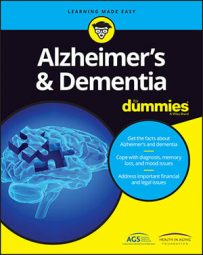Of course, some people can make even the simplest practical tasks — from changing a light bulb to hanging a picture — seem extraordinarily difficult. But in a person with dementia, a combination of changes in the brain can make struggling with many of life's little tasks that the following sections discuss the rule rather than the exception.
Which shoe on which foot?
As a young man, co-author Dr. Atkins's uncle was an engineer in the army. In later life he taught often extremely intricate engineering skills to young recruits in the Royal Electrical and Mechanical Engineers (the UK equivalent of the Army Corps of Engineers). Unfortunately, as an elderly man he developed dementia and became incapable of dressing himself without ending up with something inside out or the buttons fastened incorrectly, and even his shoes on the wrong feet.As a former military man, he certainly knew how to dress, and when Dr. Atkins was a young man at school, his uncle taught him how to shine his shoes until he could see his reflection in their toecaps. But these changes in his attire weren't due to sloppiness because he was running late or had dressed in the dark, which explains most of Dr. Atkins's wardrobe malfunctions. This uncle got it wrong every time, in different ways, and when his shoes looked scuffed and unpolished, Dr. Atkins and his family knew that something was seriously wrong.
This sort of confusion is extremely common in dementia and is associated with a slowing down of the whole dressing process, because each stage needs to be focused on and is invariably carried out incorrectly. Clothes that were always spotless may start to appear dirty or un-ironed, and the person's appearance may well show a lack of the effort previously put into maintaining it.
This is an example of a problem with what is called executive function: putting plans into action. The more steps involved, the more difficult they are to perform. Executive functions include planning, organizing, sequencing, and abstracting abilities. Any loss in executive functions impacts a patient's ability to make decisions, make and follow plans, establish goals, control impulses, think abstractly, and reason and solve problems.
Kitchen nightmares
Although most people are able to go through the process of preparing a familiar meal without much effort, and can certainly follow a recipe fairly easily, people with dementia start to find this a struggle and would soon have Gordon Ramsay yelling expletives at them if they were cooking in one of his kitchens.One function of long-term memory is to help you remember how to carry out various common practical procedures so you can do them on autopilot rather than think each stage through every time. The retrieval of these memories can be impaired in dementia, making the process of changing a light bulb, riding a bike, or whipping up a plate of ham and eggs more difficult.
Short-term memory problems and difficulties with timing also mean that food can often be burned, undercooked, or left cold in the oven long enough to grow a layer of mold on top. People with dementia may have stacks of spoiled rotten food in their refrigerator due to their inability to properly perform food preparation as well as their forgetting to eat the prepared food family members so graciously bring to them.
Housework becoming a chore
A change in the way a formerly independent person keeps her home can be another indicator of dementia when coupled with other changes. The person may forget to do housework or simply become distracted halfway through, but a dirty home may also be the result of the loss of initiative that features in the top ten early warning signs of dementia. The houses of the chronically untidy can, of course, simply just become even worse. Dr. Atkins remembers visiting an old man who was sitting in his armchair surrounded by piles of dirty, moldy plates and old newspapers, with a bucket in the middle of the room that served as a toilet.Hoarding is another common behavior in dementia patients. Especially if the individual developing dementia has always been a bit of a pack rat, such behavior as collecting things can go to the extreme of hoarding. Newspapers can become stacked everywhere in the living room, mail (including unpaid bills) can be piled on the counters, trash can accumulate in the kitchen, and plastic grocery bags can fill closets. Medications may become stockpiled because the patient forgets why he is taking them or doesn't remember how much to take.
Sometimes this behavior comes from the person with dementia being confused at how to handle a situation, like his inability to pay bills so they stack up unpaid. Other times items are hoarded because the person with dementia fears his memories will be lost without tangible evidence of the past. As brain function decreases and confusion increases, hoarding can become a safety hazard with junk piles throughout the house that are a tripping as well as a significant fire hazard.
